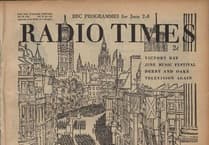Henry Bloom Noble has been in the news a little recently.
I have to admit that other than those properties we all recognise which benefited greatly from his generosity either in life or after his death, I knew little about him.
I sometimes walk through Braddan cemetery near the school and the family grave is adjacent to the pretty white painted chapel complete with the east window designed by Baillie Scott who also designed the small building by the entrance.
A little further into the cemetery, the world renowned ‘arts and crafts’ movement designer Archibald Knox is buried and I always take a little time when passing. So thanks to Wikipedia and the contribution of John Sharpe in ‘the new Manx Worthies’ published by the Manx Heritage Foundation in 2006 , I set out here to share some of his life story.
Born in Clifton, Westmoreland in June 1816 his is a story of ‘rags to riches’ a childhood of poverty, who went on to excel at school to become a prodigy of Victorian enterprise who flourished on Manx soil.
Though pre-eminent in the world of business, Noble lived unostentatiously and did not aspire to high-public office.
His long-life passion was was dedicated to the ruthless pursuit of wealth, yet his huge fortune was left to charity.
He never courted popularity, but won his place as the island’s greatest benefactor. He arrived in the island aged 19 to work in Spittall’s Wine and Spirit Merchants in Douglas.
He was later to recall that he stepped ashore from a schooner in Douglas quayside in 1835 ‘in clogs and with a single pair of breeches, and they patched’.
It was a good time for an ambitious young man to be landing in Douglas.
The Steam Packet Company had started up in 1830, the lead mines were booming and tourism was starting, with new buildings going up and the wine and spirits trade profiting as a result.
Within five years he was managing Spittall’s whole Douglas enterprise, and by the age of 25 had set up in opposition to them, as well as launching out into property speculation and had business in the great Laxey mines as well as advertising himself as a money lender. He branched out into the sale of seeds and other commodities for farmers, then opened a timber yard near Bank’s Hill and transferred his wine and spirits business to St George’s Street now occupied by Joseph Bucknall and Sons.
His timber yard was located in the large area between Hill Street and Myrtle Street in the area where St Mary’s Church now stands. He owned the whole block.
Large profits were generated and he next invested in shipping.
The first ship he owned was named ‘Jane and Agnes’ and the next, ‘Rebecca and Maria’, was said to have been two of the finest and smartest schooners operating out of Douglas.
Both were used in connection with his own business and others included the Great Laxey Mining Company.
He was reputed to be the richest man in the island and was still unmarried and living with his octogenarian mother. By age of 45, however, he married Rebecca Thompson, two years his junior at Braddan. By the 1880s Henry Bloom Noble had become a major shareholder in the Steam Packet serving on the board of directors as chairman.
However, his vision for the company was to promote the introduction of fast screw-driven steamers, but the rest of the board still favoured paddle-driven ships.
This largely brought about his resignation but by the turn of the century it was clear that his proposal had been the correct way forward.
Despite his resignation he still supported the Steam Packet in a price war with the ‘Isle of Man, Liverpool and Manchester Steamship Company’ to the extent of several million pounds at today’s prices which was repaid when the island company acquired its competitor in 1888. Noble had made infrastructure investments to help accommodate the boom in tourism.
Investing in the Douglas Gas Light Company and as one of the founders of the Douglas Water Works Company a post he held until the company was acquired by the Douglas Town Council.
Noble was one of the founders of the Isle of Man Bank a position held for more than 25 years and at the time of the purchase of the Douglas Water Works company, the town’s local authority banked with Dumbell’s Bank.
Noble refused a cheque drawn on Dumbell’s Bank but insisted on cash. Did he have any idea what was later to come about? Noble worked with Governor Loch on the construction of Victoria Street and his astute vision led him to acquire many of the most desirable building plots in the town and at one stage he was one of the proprietors of the castle mona estate which was sold on to a syndicate at over 10 million pounds at todays money.
The property was the former residence of the Dukes of Atholl.
In 1868 he bought the Villa Marina which at that time was rented as the residence of then Governor Francis Pigott.
It is said that many peopled scoffed at the purchase price but as ever Noble was proved correct as he was subsequently offered a figure more than 15 times his purchase price and upon his death in 1903 it was bequeathed to the town of Douglas. Some Victorians recognised that while they were successful there were many in really difficult circumstances.
Many residents had no access to healthcare so, having prevented a bid from the hospital committee to build on land they owned, Rebecca and Henry gave the land and built the first Noble’s Hospital at their cost on the site which is now the Manx Museum in Kingswood Grove. Rebecca is remembered as a great benefactor to the island’s poor people. Prior to his death Henry Bloom Noble, who was predeceased by Rebecca, established the Henry Bloom Noble Trust, one of the oldest charities in the island, having been established in 1888 as the trustees of Noble’s Hospital and Dispensary.
It became a statutory body in 1909 and in 2003 was renamed the Henry Bloom Noble Healthcare Trust.
Numerous bequests have benefited the Isle of Man such as the construction of St Ninian’s Church, Noble’s Park, Ramsey Cottage Hospital, the Douglas Soup Dispensary (perhaps better known as the soup kitchen in Myrtle Street), Knockaloe farm and much more.
Apart from a few small bequests to his staff and relatives on Rebecca’s side he left everything to charity. I wasn’t aware that Henry Bloom Noble had held the position of Captain of the Parish of Lonan from 1885 until his death or that the stained glass windows in the east of St George’s Church were erected by him.
I didn’t know that he was the chief contributor to the home for the aged poor (perhaps better remembered as the house of industry) and for many years he supplied those in residence with their Christmas dinner.
One of the things I do remember clearly was Noble’s Baths in Victoria Street. A man with foresight who seized opportunities and who with his wife made such a difference for his adopted town.
.jpg?trim=139,0,358,0&width=752&height=500&crop=752:500)



